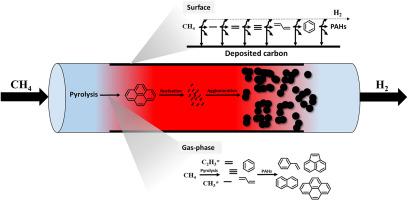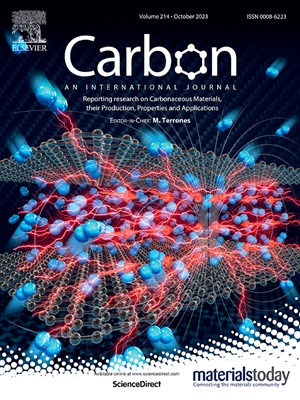调查 CH4 热解反应器中烟尘的形成:数值、实验和特性研究
IF 10.5
2区 材料科学
Q1 CHEMISTRY, PHYSICAL
引用次数: 0
摘要
甲烷热解是一种很有前景的环保型制氢方法,但烟尘的形成和碳的相互作用给扩大规模带来了挑战。因此,了解煤烟形成和碳沉积的动态至关重要。本研究深入探讨了在工业相关条件下甲烷热解过程中烟尘形成的复杂性,即在常压下操作,采用 2 的 H2:CH4 比率,并探索一系列热区温度(1473 K、1573 K、1673 K 和 1773 K)和 5 秒停留时间。该研究利用详细的气相动力学模型与直接碳沉积反应,采用矩法结合一维塞流反应器模型模拟烟尘的形成。通过透射电子显微镜、动态光散射(DLS)和拉曼光谱对热解反应器中产生的烟尘颗粒进行表征,验证了该模型。结果表明,较低的温度会导致以成核为主的生长,而较高的温度则会由于碳沉积而明显抑制颗粒的生长。DLS 数据表明,颗粒生长和沉积过程之间存在复杂的平衡关系。这些发现为通过减少烟尘和碳沉积来提高反应器性能和制氢过程可持续性的操作参数提供了启示。本文章由计算机程序翻译,如有差异,请以英文原文为准。

Investigating the formation of soot in CH4 pyrolysis reactor: A numerical, experimental, and characterization study
Methane pyrolysis is a promising method for eco-friendly hydrogen production, but soot formation and carbon interaction pose challenges for scaling up. Therefore, understanding the dynamics of soot formation and carbon deposition is crucial. This study delves into the intricacies of soot formation in methane pyrolysis under industrially relevant conditions, namely operations at atmospheric pressure, employing a H2:CH4 ratio of 2 and exploring a range of hot zone temperatures (1473 K, 1573 K, 1673 K, and 1773 K) with a 5 s residence time. Utilizing a detailed gas-phase kinetic model with direct carbon deposition reactions, the research adopts the method of moments coupled with a one-dimensional plug flow reactor model to simulate soot formation. The model is validated by characterizing soot particles that were produced in a pyrolysis reactor by means of transmission electron microscopy, Dynamic light scattering (DLS), and Raman spectroscopy. Results show that lower temperatures lead to nucleation-dominated growth, whereas higher temperatures significantly restrain particle growth due to carbon deposition. DLS data indicate a complex balance between particle growth and deposition processes. These findings provide insights into operational parameters that can enhance reactor performance and sustainability in hydrogen production processes by mitigating soot and carbon deposition.
求助全文
通过发布文献求助,成功后即可免费获取论文全文。
去求助
来源期刊

Carbon
工程技术-材料科学:综合
CiteScore
20.80
自引率
7.30%
发文量
0
审稿时长
23 days
期刊介绍:
The journal Carbon is an international multidisciplinary forum for communicating scientific advances in the field of carbon materials. It reports new findings related to the formation, structure, properties, behaviors, and technological applications of carbons. Carbons are a broad class of ordered or disordered solid phases composed primarily of elemental carbon, including but not limited to carbon black, carbon fibers and filaments, carbon nanotubes, diamond and diamond-like carbon, fullerenes, glassy carbon, graphite, graphene, graphene-oxide, porous carbons, pyrolytic carbon, and other sp2 and non-sp2 hybridized carbon systems. Carbon is the companion title to the open access journal Carbon Trends. Relevant application areas for carbon materials include biology and medicine, catalysis, electronic, optoelectronic, spintronic, high-frequency, and photonic devices, energy storage and conversion systems, environmental applications and water treatment, smart materials and systems, and structural and thermal applications.
 求助内容:
求助内容: 应助结果提醒方式:
应助结果提醒方式:


